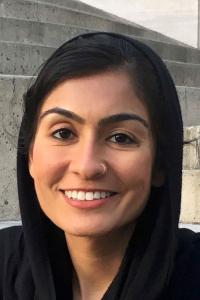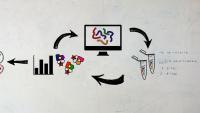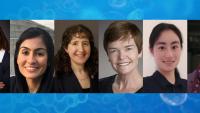Anum Glasgow, PhD
- Assistant Professor of Biochemistry and Molecular Biophysics

Overview
Academic Appointments
- Assistant Professor of Biochemistry and Molecular Biophysics
Gender
- Female
Credentials & Experience
Education & Training
- BS, 2009 Biomedical Engineering, Johns Hopkins University, Baltimore, MD
- PhD, 2015 Bioengineering, UC Berkeley, Berkeley, CA
- Fellowship: 2021 Biophysics, UCSF, San Francisco, CA
Honors & Awards
- NIH K99/R00: “Mapping and rewiring protein allostery”, 2020-2025
- UCSF Chancellor’s Postdoctoral Fellowship, 2018-2020
- NIH IRACDA Postdoctoral Fellowship, 2016-2019
- Sandia National Labs/UC Berkeley Excellence in Engineering Graduate Fellowship, 2013-2015
- NSF Graduate Research Fellowship, 2010-2013
Research
The diversity of natural proteins shapes cell- and tissue-level structure and behavior, and advances in protein engineering have enabled the de novo design of artificial, super-stable proteins. But real proteins have evolved to depend on biomolecular interactions and conformational flexibility in order to balance stability with function. A key challenge in protein engineering is our limited mechanistic understanding of how proteins’ conformational ensembles are poised to perform non-equilibrium processes, which enable their functions.
Our research group combines computational protein design with high-throughput biophysical techniques to study biomolecular conformational changes, towards engineering proteins that change conformations, interact with other molecules, and cross membranes in response to signals. Design principles for building signal-responsive, conformation-switching proteins can guide efforts to control the behavior and development of living systems and treat diseases without disrupting healthy cells. Our long-term goal is to engineer multi-functional proteins and therapeutics that respond to ligand binding and correct localization via programmed conformational changes. This work serves the public by growing our knowledge of biomolecular behavior and opening new paths to treat disease.
Website: https://www.glasgowlab.org
Selected Publications
A. Glasgow*, J. Glasgow*, D. Limonta, P. Solomon, I. Lui, Y. Zhang, M. Nix, N. Rettko, S. Zha, R. Yamin, K. Kao, O. S. Rosenberg, J. V. Ravetch, A. P. Wiita, K. K. Leung, S. A. Lim, X. X. Zhou, T. Hobman, T. Kortemme, J. A. Wells, “Engineered ACE2 receptor traps potently neutralize SARS-CoV-2.” Proceedings of the National Academy of Sciences USA 2020, 117(45) pp. 28046-28055.
A. Glasgow*, Y-M. Huang*, D. J. Mandell*, M. C. Thompson, R. Ritterson, A. L. Loshbaugh, J. Pellegrino, C. Krivacic, R. A. Pache, K. A. Barlow, N. Ollikainen, D. Jeon, M. J. S. Kelly, J. S. Fraser, T. Kortemme, “Computational design of a modular protein sense/response system.” Science 2019, 366(6468), pp. 1024-1028.
A. Glasgow, H. T. Wong and D. Tullman-Ercek, “A secretion-amplification role for Salmonella translocon protein SipD.” ACS Synthetic Biology 2017, 6(6), pp. 1006-1015.
A. Azam and D. Tullman-Ercek, “Type-III secretion filaments as scaffolds for inorganic nanostructures.” Journal of the Royal Society Interface 2016, 13(114) p. 20150938.
A. Azam, C. Li, K. J. Metcalf and D. Tullman-Ercek, “Type III secretion as a generalizable strategy for the production of full-length biopolymer-forming proteins.” Biotechnology and Bioengineering 2015, 113(11) pp. 2313-2320.
A. Azam, K. Laflin, M. Jamal, R. Fernandes and D. H. Gracias, “Self-folding micropatterned polymeric containers.” Biomedical Microdevices 2011, 13(1) pp. 51-58.

